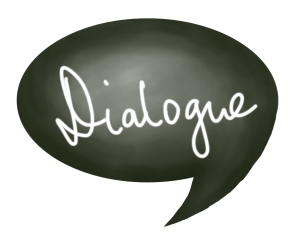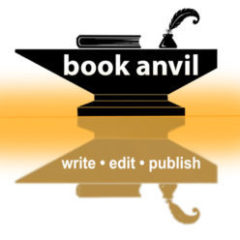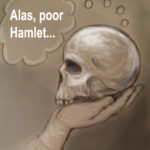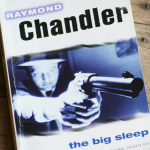
Dialogue is a conversation between two or more characters (real or imaginary). However it’s easy to confuse a reader by failing to establish who says what and where. This post will run through the many methods by which writers show who’s speaking. In a way it will also help you build a sense of character, though character-in-dialogue is easily worth a separate post.
Direct attribution
Direct attribution is the commonest way to illuminate who’s speaking. When you specify who says something, you’re using direct attribution.
However this can easily be overdone:
John and Judy sat on couches regarding each other. Judy spoke first.
‘So what do you think we should do about Martha?’ Judy said.
‘I don’t know,’ said John. ‘Is she becoming a problem?’
‘Only if you believe in privacy,’ said Judy.
As you can see, this partial scene is too heavily underscored with attributions (as character names) to make smooth reading.
However there’s no need to attribute so heavily. Readers can intuit who speaks once a pattern has been established. For instance, the above half-scene uses a back-and-forth style of conversation. When two speakers are involved, the reader naturally expects one to speak and then the other, taking turns. This means we can remove most attributions without confusing the reader:
John and Judy sat on couches regarding each other.
‘So what do you think we should do about Martha?’ said Judy.
‘I don’t know. Is she becoming a problem?’
‘Only if you believe in privacy.’
However to add emphasis to the last line of a scene, it’s quite acceptable to attribute it even though the reader knows who’s talking. That’s up to you. For me, reducing the number of attributions so they don’t dominate the work is one key to producing better dialogue.
When to attribute?
In most scenes you’d probably attribute the opening speaker. You’d attribute speech if a new speaker enters the dialogue. But once a back-and-forth pattern has been established, until that pattern is broken or interrupted, you can be sparing.
Meanwhile, keep in mind that direct attribution is only one way of indicating who says something. Attributions like ‘he said’ and ‘she said’, while so low-key as to seem almost invisible, can flounder if the writer hasn’t tried to distinguish speakers in other ways.
So what better way to make dialogue work than infuse it with character?
Character-in-speech
Consider the following:
‘Where were you on the night of the fifth?’
‘The fifth? When the hell was that?’
‘Don’t be cute. The night your business partner disappeared.’
‘Aw, let’s see. I was with my girlfriend.’
‘She says you weren’t. Not only that but she says you turned up on her doorstep next morning covered in blood. Going to tell me where you were the night before?’
‘You’re so smart, you tell it.’
Although there are no attributions to work with, it’s clear that the person who opens the scene above is a detective and the second speaker is a suspect. The first character speaks interrogatively, the second defiantly. There’s a strong back-and-forth pattern to the dialogue that makes it easy to keep track of who’s speaking and when.
While you may not write in the same way, all your characters’ dialogue should be rooted in who they are, what they believe or think, and their current state of knowing. Thus although it’s easy to overdo accent and phrasing, it’s also important to pay attention to how individuals speak. Setting two speakers apart in terms of how they talk can be highly effective at both strengthening characterisation and delineating the speaker.
Indirect attribution
Not all attributions have to be as direct as ‘she said’.
What film and theatre people call ‘stage directions’ include expressions, gestures, actions and other indirect cues. When applied in the same paragraph as the character’s speech, readers are left in no doubt as to speaker:
The sisters sat on couches.
Jill spoke first. ‘So what do you think we should do about Martha?’
‘I don’t know.’ Judy reached for a sugar cube and stirred it into her tea. ‘Is she becoming a problem?’
‘Only if you believe in privacy.’
‘I honestly can’t say I’ve noticed anything.’
With a sigh Jill pulled the note out of her skirt pocket and passed it across. ‘That’s because you haven’t seen this.’
The other woman put her teacup down and began reading. A finger went to her mouth and began to twist itself between her incisors. Finally she looked up from the note, her face ashen. ‘Did Martha really write this? But that’s so odd. It says—’
‘I know what it says,’ said Jill. ‘I just don’t know what we’re going to do about it.’
In the above example, indirect attribution is used more generously than direct attribution, but both are in balance. The result has a good deal more energy and flow than it otherwise might.
When crafting dialogue, the trick is to balance your work so ‘he said’ and ‘she said’ don’t become the only ways you indicate who speaks. Paying attention where possible to stage directions, character differentiation and conversational rhythm will go a long way toward providing clarity without over-telling. Into the bargain they’ll add depth and colour to your work.
Varying attibutions
Many writers try to vary the way they attribute dialogue to avoid repeating ‘said’. For instance they might use ‘she growled’ or ‘she muttered’ or ‘he volunteered’ or ‘he stated’.
However changing the verb to avoid repetition is usually a mistake. If repeating ‘John said’ and ‘Judy said’ wearies the reader, imagine how much more tiring it is to read constantly shifting verbs like ‘John uttered’, ‘Judy whispered’, ‘John sang,’ ‘Judy chortled’, and so forth.
Does this mean you can’t use ‘whispered’ or even ‘chortled’? Heck, no. Use them if they add important meaning to the dialogue (that is, if the way something is spoken matters). Just be sparing, or your work will seem overly burdened by attention-grabbing attributions. Bear in mind, too, that many editors detest any attempt to make the attribution verb more important than it should be.
You can, however, vary the noun whenever you wish. That is, instead of repeating ‘John said’, you can sometimes substitute a different two-word phrase that describes John. Is he Judy’s brother? In that case you could sometimes use ‘her brother said’. Or does he have a military rank? In that case it could be ‘the captain said’. Is he taller, shorter, leaner? Younger? Try ‘the younger man said.’ Varying the noun is a useful tactic when you have two characters of the same gender talking in the same scene, and don’t want to constantly repeat their names during attribution. Just be careful not to confuse readers by referring to one character as ‘the younger man’ only to use ‘the taller man’ later in the same scene. As with every detail you employ in scene-building, consistency matters.
Note that since gender is itself a useful distinction, once you’ve indicated that a room has two characters of opposite genders in it, ‘he said’ and ‘she said’ are all that’s required. You’ll find that he-she scenes are seldom cluttered with names.
Minor matters: how to punctuate broken speech
Sometimes one speaker delivers a long-winded piece of dialogue that contains a paragraph break. The key to making sure the reader knows it’s still the same person talking is to punctuate and use line breaks correctly. Here’s an example:
Samuel stood and raised his glass. ‘And so we come to that part of the evening when gentlemen and ladies rise and take a toast,’ he said. ‘May I congratulate the father of the bride, the mother, the father’s mother, and all the rest of her family to the year dot; may I also offer to the groom himself the heartfelt wish that marriage satisfy all his dreams.
‘Oh, and one other thing: the wine is poisoned.’
The lack of a closing quotation mark at the end of the first paragraph tells a reader that the second paragraph is by the same speaker.
However when it comes to interruptions within speech, options differ. For instance if the interruption isn’t itself a section of speech, you can continue within the same paragraph, using dashes and a comma to set the interruption apart:
‘Wait a minute,’ said John hotly, ‘you said Martha was busy. Now you tell me she’s on her way here—’ he ignored Jake’s attempts to interject, ‘—and even worse, she’s bringing her boyfriend.’
Notice that the broken dialogue is set apart by dashes within the quote marks, while the interrupting part is set apart by a single comma.
Contrast the above to the proper way to punctuate and line break when the interruption is itself in the form of speech:
‘Wait a minute,’ said John hotly, ‘you said Martha was busy. Now you tell me she’s on her way here—’
‘I didn’t mean that,’ Jake cut in.
‘—and even worse, she’s bringing her boyfriend.’
In the above example a new line indicates that a new speaker is speaking. This avoids the confusion that might result from two sets of quotation marks running side-by-side.
Sometimes speech is broken up by the mid-placement of an attribution. Writers shouldn’t be nervous of changing their phrasing in this way. Actually it’s vital to alter the balance of short, long and interrupted sentences so readers don’t grow jaded. For instance:
‘We were going along very nicely,’ said Jason, ‘until your brother got here.’
Notice that, because the dialogue continues after the attribution (which isn’t considered an interruption as such), there’s a comma inside the end-quote mark to show that the sentence has paused, then there’s the attribution with a comma of its own, then the dialogue continues without a capital letter.
One last tip about dialogue and attributive verbs…
Very commonly, writers do things like this: ‘But I gave you everything!’ he exclaimed. The exclamation point says enough, so ‘he exclaimed’ adds nothing.
Always use attributions that are as natural as possible or that add essential nuance.
With all the above tips and tricks up your sleeve, now’s the time to go back to your dialogue-heavy scenes to see if they need tweaking.


 In this post I’ll take a tour through what constitutes ‘head-hopping’ and what doesn’t.
In this post I’ll take a tour through what constitutes ‘head-hopping’ and what doesn’t.




